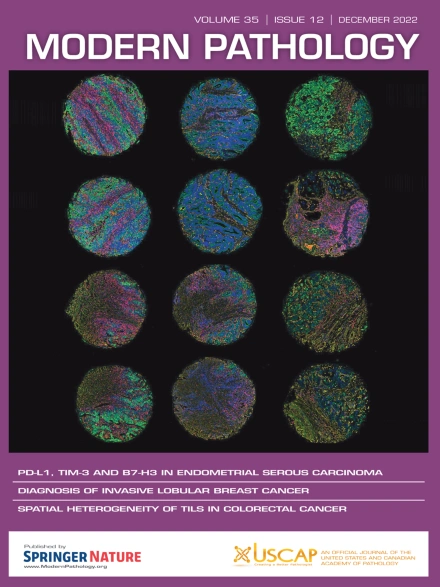基于注意力的全片图像压缩实现了病理水平的多器官常规组织病理学活检的预筛选。
IF 7.1
1区 医学
Q1 PATHOLOGY
引用次数: 0
摘要
早期发现癌症(如结肠直肠癌和宫颈癌)的筛查项目导致了对活检组织病理学分析的需求增加。深度学习的高级图像分析显示了在数字病理全幻灯片图像中自动检测癌症的潜力。特别是,弱监督学习可以实现整个幻灯片图像分类,而不需要繁琐的手动注释,只使用幻灯片级别的标签。在这里,我们使用来自n=9,141个组织块的n=12,580张整张幻灯片图像的数据来训练和验证基于神经图像注意压缩(nica)的弱监督深度学习方法,该方法使用从病理报告中提取的标签。我们还介绍了Slide Packing,这是一种将同一组织块的多个幻灯片中的组织合并到与块级标签链接的单个“打包”图像中的方法。NIC-A可将结肠和宫颈组织滑膜分为癌组织、高级别发育不良组织、低级别发育不良组织和正常组织,并可在十二指肠活检中发现乳糜泻。我们分别通过来自两个欧洲中心的四名和三名病理学家小组验证了nica在结肠和子宫颈的疗效。我们表明,所提出的方法在检测和分类异常方面达到了病理学家水平的表现,这表明它有可能通过减少常规数字病理诊断的工作量来帮助病理学家进行预筛选工作流程。本文章由计算机程序翻译,如有差异,请以英文原文为准。
Attention-Based Whole-Slide Image Compression Achieves Pathologist-Level Prescreening of Multiorgan Routine Histopathology Biopsies
Screening programs for the early detection of cancers, such as colorectal and cervical cancers, have led to an increased demand for histopathological analysis of biopsies. Advanced image analysis with deep learning has shown the potential to automate cancer detection in digital pathology whole-slide images. In particular, weakly supervised learning can achieve whole-slide image classification without the need for tedious, manual annotations, using only slide-level labels. Here, we used data from n = 12,580 whole-slide images from n = 9141 tissue blocks to train and validate a weakly supervised deep learning approach based on Neural Image Compression with Attention (NIC-A) using labels extracted from pathology reports. We also introduced slide packing, a method that merges tissue from multiple slides of the same tissue block into a single “packed” image linked to block-level labels. NIC-A classifies colon and cervical tissue slides into cancer, high-grade dysplasia, low-grade dysplasia, and normal tissue and detects celiac disease in duodenal biopsies. We validated NIC-A for colon and cervix against panels of 4 and 3 pathologists, respectively, on cohorts from 2 European centers. We show that the proposed approach reaches pathologist-level performance in detecting and classifying abnormalities, suggesting its potential to assist pathologists in prescreening workflows by reducing workload in routine digital pathology diagnostics.
求助全文
通过发布文献求助,成功后即可免费获取论文全文。
去求助
来源期刊

Modern Pathology
医学-病理学
CiteScore
14.30
自引率
2.70%
发文量
174
审稿时长
18 days
期刊介绍:
Modern Pathology, an international journal under the ownership of The United States & Canadian Academy of Pathology (USCAP), serves as an authoritative platform for publishing top-tier clinical and translational research studies in pathology.
Original manuscripts are the primary focus of Modern Pathology, complemented by impactful editorials, reviews, and practice guidelines covering all facets of precision diagnostics in human pathology. The journal's scope includes advancements in molecular diagnostics and genomic classifications of diseases, breakthroughs in immune-oncology, computational science, applied bioinformatics, and digital pathology.
 求助内容:
求助内容: 应助结果提醒方式:
应助结果提醒方式:


